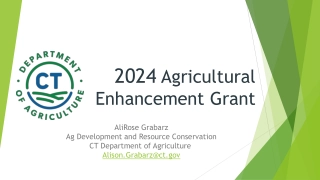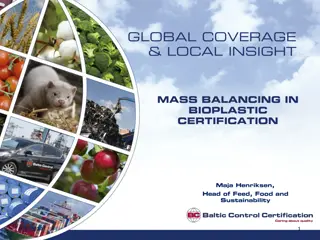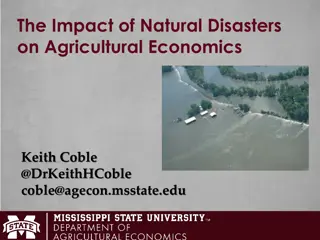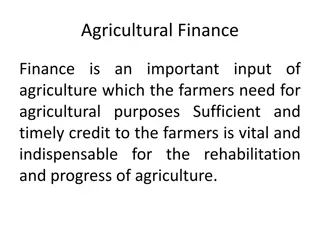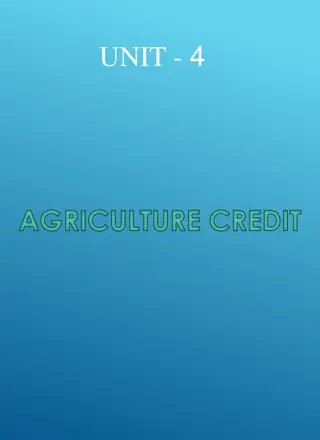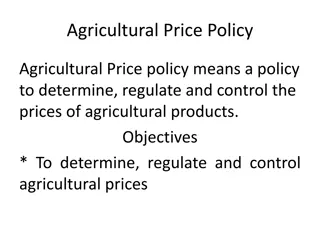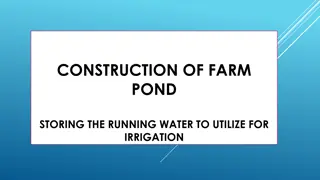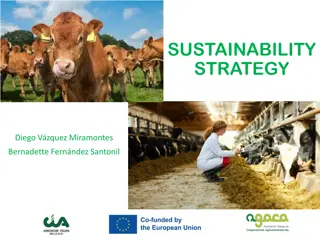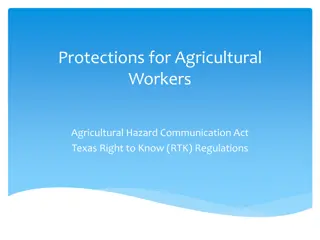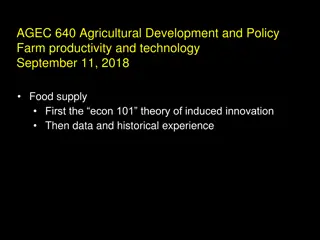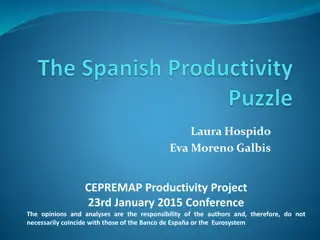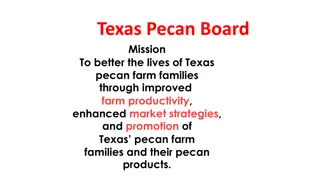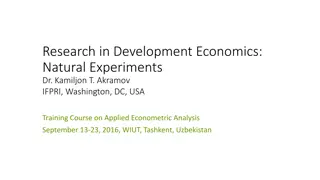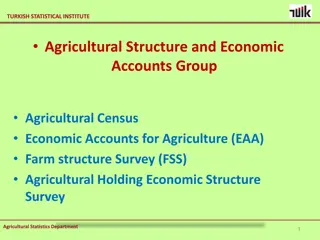Improving Agricultural Productivity and Environmental Sustainability in Texas
The USDA NRCS EQIP Edwards Aquifer State Resource Concern (EA SRC) program in Texas aims to enhance local agriculture productivity and environmental objectives by focusing on water quality, erosion reduction, efficient water usage, and addressing climate change impacts. The program provides voluntary conservation practices and funding to agricultural producers to implement measures that benefit working agricultural lands. Other similar State Resource Concerns (SRCs) in Texas have been established to address various environmental issues such as soil quality, water quality and quantity, air and plant health. The program emphasizes measurable watershed results within a set time frame, with potential for future SRC goals. EAA plays a critical role as an SRC sponsor in collaborating with NRCS to select practices and evaluate applications for approval.
Download Presentation

Please find below an Image/Link to download the presentation.
The content on the website is provided AS IS for your information and personal use only. It may not be sold, licensed, or shared on other websites without obtaining consent from the author.If you encounter any issues during the download, it is possible that the publisher has removed the file from their server.
You are allowed to download the files provided on this website for personal or commercial use, subject to the condition that they are used lawfully. All files are the property of their respective owners.
The content on the website is provided AS IS for your information and personal use only. It may not be sold, licensed, or shared on other websites without obtaining consent from the author.
E N D
Presentation Transcript
USDA Natural Resources Conservation Service (NRCS) Environmental Quality Improvement Program (EQIP) Edwards Aquifer State Resource Concern (EA SRC) EA SRC Program Summary Jim Boenig, P.E. Director of Aquifer Protection, EAA
Discussion Topics EQIP SRC Program Overview Other SRCs in Texas Proposed NRCS Practices EAA Responsibilities as an SRC Sponsor Annual Tasks and Schedule
USDA NRCS EQIP EA SRC Program Overview Non-Regulatory: Voluntary conservation program for agricultural producers. Benefits Ag Productivity and Environment: Practices benefit working agricultural land. Additional NRCS Funding: EA SRC EQIP funding is in addition to County-based NRCS EQIP funding. ($3M-$6M in 5 yrs., estimated.) EAA funding is separate from EQIP funding to provide incentives. Focus on Local Environmental Priorities: Program Sponsor (EAA) assists NRCS to select beneficial practices and develop ranking criteria to evaluate applications for approval. Results Oriented: Approved applicants must commence Practice within 1 year of contract award. Payment incentive paid by NRCS (typically 30 to 50%) only after Practice is installed and certified to meet NRCS standards. Measurable Benefits: Each SRC Program is designed to achieve measureable watershed results within 5 years and terminate. If successful, a new SRC with new goals can be applied for in future years.
Priorities of Other SRCs in Texas 12 SRCs were established in Texas during FY 2015. 4 SRCs were added in FY 2016 including the EA SRC Statewide SRCs include: Poultry, Dairy, Beef Confined Animal Feeding Operations (CAFO) Concerns: Soil Quality and Erosion, Water Quality and Quantity, Plant Health, Air Quality, Animal Health. SRCs in portions of our Region include: Nueces River Basin (Sponsor NRA) Concerns: Watershed Water Quality and Water Quantity 2015: 33 contracts for $511K, only 1 in our area for $9,708. SRCs with similar goals include: Highland Lakes (Sponsor LCRA) Concerns: Water Quality, Water Quantity, Soil Erosion, Soil Health Central Gulf Coast Irrigation (Sponsor Rice Council) Concerns: Water Quality, Water Quantity, Soil Erosion, Soil Health, Wildlife Habitat Primary Strategy: Installation of Water Conserving Practices
Goals of the EA SRC Program Enhance Local/Regional agriculture productivity and environmental objectives. Location Recharge & Contributing Zones: Artesian Zone: pollution EAA Resource Objectives: Water Quality - Reduce erosion (land and stream), decommission substandard wells. Water Quantity Efficient use of water, lower water demand by improving soil health. Climate Change Reduce energy consumption, absorb carbon, reduce emissions. Focus Areas Improve Soil Health, Reduce Erosion Efficient Irrigation, Reduce potential
Resource Concerns and Recommended Practices l Primary Focus Includes EAA Partial Reimbursement within Jurisdictional Boundary Water Quality Degradation (Excessive Sediment) in Contributing and Recharge Zones Rangeland and Riparian Areas (550) Range Planting, (390) Riparian Herbaceous Cover, (391) Riparian Forest Cover, (528) Prescribed Grazing, (314) Brush Management (Mechanical). Water Quantity (Inefficient Use) in Artesian Zone (441) Micro-Irrigation System, (442) Sprinkler Irrigation System, (449) Irrigation Water Well Management. Water Quality Degradation (Pollutants) within Edwards Aquifer System (351) Well Decommissioning (Edwards) (319) On-Farm Secondary Containment
Resource Concerns and Recommended Practices l Secondary Focus Water Quality Degradation (Excessive Sediment) in Edwards System to benefit cropland - Non-Structural (512) Forage & Biomass Planting, (386) Field Border, (393) Filter Strip, (412) Grassed Waterway, Residue & Tillage Management (329) No Till or (345) Mulch Till. Water Quality Degradation (Excessive Sediment) in Contributing and Recharge Zone - Structural (580) Streambank Protection, (638) Water & Sediment Control Basin. (600) Terrace,
EAA Responsibilities as an SRC Sponsor Develop the EA SRC Proposal: Select SRC practices and the boundary for each practice. Provide community outreach and gather feedback for mutual benefit of Ag producers and the EAA. Provide EAA funding to provide incentives for the prioritized practices. (EAA funding is not a SRC requirement. Develop methods to measure expected environmental improvements from each Practice.
EAA Responsibilities as an SRC Sponsor Annual tasks after the EA SRC is approved: Develop the scoring/ranking criteria of Practices with NRCS Staff. Conduct outreach meetings and create brochure to notify Ag Producers of Program details. Field inspect in order to administer payment of EAA incentives, if applicable. Track measures which quantify benefits of Practice implementation. Document Program successes with field visits and interviews. Provide annual reports of Program project implementation and beneficial impacts. Review Program effectiveness and Practice scoring/ranking criteria on an annual basis.
Local Partners/ Community Outreach Develop partnerships with Agricultural organizations Farm Bureau Soil & Water Conservation Districts Local Groundwater Districts and River Authorities Provide community outreach and educational meeting(s). Inform Ag Producers within the EA SRC focusing on Uvalde, Medina, Bexar, Comal, and Hays Counties. Obtain feedback from the Ag community for program improvements which can be made on an annual basis. Provide case studies of property and watershed improvement impacts for selected Owners willing to participate.
Annual Program Schedule (Approximate) NRCS Notification of annual EA SRC EQIP Funding Nov - Feb NRCS EQIP Evaluation of Applicants Multiple, TBD NRCS initiates EQIP Contracts Multiple, TBD Outreach and Monitor the EA SRC Program Apr - Dec Develop EAA program budget for following year Jun - Sep Review EA SRC Goals, Practices, and Ranking Criteria Oct - Dec EAA Partial Reimbursement for Completed Practices Nov - Dec



